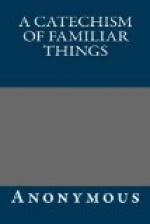The irruption of Barbarians into Italy and Southern Europe, proved fatal to painting, and almost reduced it to its primitive state; it was not until after a long period that it was fully restored. The first certain signs of its revival took place about the year 1066, when Greek artists were sent for to adorn several of the cities of Italy. Cimabue, a native of Florence, in the thirteenth century, caught the inspiration of the Greek artists, and soon equalled their works. He was both a painter and an architect.
Irruption, inroad, invasion.
To what did this revolution in its history give rise?
It caused it to be distinguished into ancient and modern. The ancient painting comprehends the Greek and Roman: the modern has formed several schools, each of which has its peculiar character and merit. The first masters who revived the art were greatly surpassed by their scholars, who carried it to the greatest state of perfection, and advanced it not only by their own noble works, but also by those of their pupils.
Who were the principal masters of the Italian school?
Raphael and the celebrated Michael Angelo Buonarotti; the former is regarded as the prince of modern painters, and is often styled “the divine Raphael;” he was born at Urbino, in 1483. Michael Angelo was born at Florence, in 1564, and united the professions of painter, sculptor, architect, poet, and musician. Besides these there were many other illustrious Italian painters, the principal of whom were Leonardo da Vinci, Titian, Correggio, the three Caracci, Guido, Parmegiano, Salvator Rosa, &c.
Was not Raphael also reckoned as excellent an architect as he was a painter?
He was not only esteemed the best painter in the world, but also the best architect; he was at least so admired for skill and taste in architecture, that Leo the Tenth charged him with the building of St. Peter’s Church at Rome.
Who was Leo the Tenth?
A great Pope, who was an ardent lover and patron of learning and the arts. He was born at Florence, in 1475, and died in 1521.
Give me a list of some of the most celebrated painters besides those already mentioned.
The great painters of the German school were Albert Durer, Holbein, Kneller and Mengs, with several others.
Of the Dutch school, were Rembrandt, Gerard Dow, Mieris, Ostade, Polemberg, Berghem, and Wouvermans.
Of the Flemish, Rubens, Teniers, Jordaens, and Vandyck.
The admired painters of the French school, were Claude, Poussin, Le Brun, and many others.
The Spaniards also have had their Murillo, Velasquez, &c.
The English, Hogarth, Wright, Reynolds, Wilson, Northcote, Gainsborough, Morland, Barry, and others.
The Americans, Washington Allston, Benjamin West, Gilbert Stuart, John Singleton Copley, John Trumbull, G. Stuart Newton, Thomas Cole, Henry Inman, and a number of others; besides many now living, or but recently deceased.




